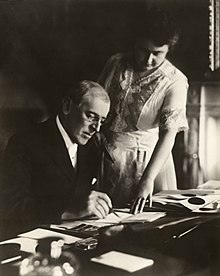
Following his attendance at the Paris Peace Conference in 1919, Woodrow Wilson returned to the United States to campaign for Senate approval of the peace treaty and the League of Nations Covenant. However, he suffered a stroke in October 1919 which left him bedridden and partially paralyzed. The United States never did ratify the Treaty of Versailles nor join the League of Nations, which had initially been Wilson’s concept. At the time, non-interventionist sentiment was strong.
Edith Wilson and others in the President’s inner circle hid the true extent of the President’s illness and disability from the American public.[36][37][38] Edith also took over a number of routine duties and details of the Executive branch of the government from the onset of Wilson’s illness until he left office almost a year and a half later. From October 1919 to the end of Wilson’s term on March 4, 1921, Edith, acting in the role of First Lady and shadow steward, decided who and which communications and matters of state were important enough to bring to the bedridden president. Edith Wilson later wrote: “I studied every paper sent from the different Secretaries or Senators and tried to digest and present in tabloid form the things that, despite my vigilance, had to go to the President. I, myself, never made a single decision regarding the disposition of public affairs. The only decision that was mine was what was important and what was not, and the very important decision of when to present matters to my husband.” Edith became the sole communication link between the President and his Cabinet. She required they send her all pressing matters, memos, correspondence, questions, and requests.
Edith took her role very seriously, even successfully pushing for the removal of Secretary of State Robert Lansing after he conducted a series of Cabinet meetings without the President (or Edith herself) present. She also refused to allow the British ambassador, Edward Grey, an opportunity to present his credentials to the president unless Grey dismissed an aide who was known to have made demeaning comments about her. She assisted President Wilson in filling out paperwork, and would often add new notes or suggestions. She was made privy to classified information, and was entrusted with the responsibility of encoding and decoding encrypted messages.
In My Memoir, published in 1939, Edith Wilson justified her self-proclaimed role of presidential “steward,” arguing that her actions on behalf of Woodrow Wilson’s presidency were sanctioned by Wilson’s doctors; that they told her to do so for her husband’s mental health.[44] Edith Wilson maintained that she was simply a vessel of information for President Wilson; however, others in the White House did not trust her. Some believed that the marriage between Edith and Woodrow was hasty and controversial. Others did not approve the marriage because they believed that Woodrow and Edith had begun communicating with each other while Woodrow was still married to Ellen Wilson.[43]
In 1921, Joe Tumulty (Wilson’s chief of staff) wrote: “No public man ever had a more devoted helpmate, and no wife a husband more dependent upon her sympathetic understanding of his problems … Mrs. Wilson’s strong physical constitution, combined with strength of character and purpose, has sustained her under a strain which must have wrecked most women”. In subsequent decades, however, scholars were far more critical in their assessment of Edith Wilson’s tenure as First Lady. Phyllis Lee Levin concluded that the effectiveness of Woodrow Wilson’s policies were unnecessarily hampered by his wife, “a woman of narrow views and formidable determination”. Judith Weaver opined that Edith Wilson underestimated her own role in Wilson’s presidency. While she may not have made critical decisions, she did influence both domestic and international policy given her role as presidential gatekeeper. Dr. Howard Markel, a medical historian, has taken issue with Edith Wilson’s claim of a benign “stewardship”. Markel has opined that Edith Wilson “was, essentially, the nation’s chief executive until her husband’s second term concluded in March of 1921”. While a widow of moderate education for her time, she nevertheless attempted to protect her husband and his legacy, if not the presidency, even if it meant exceeding her role as First Lady.